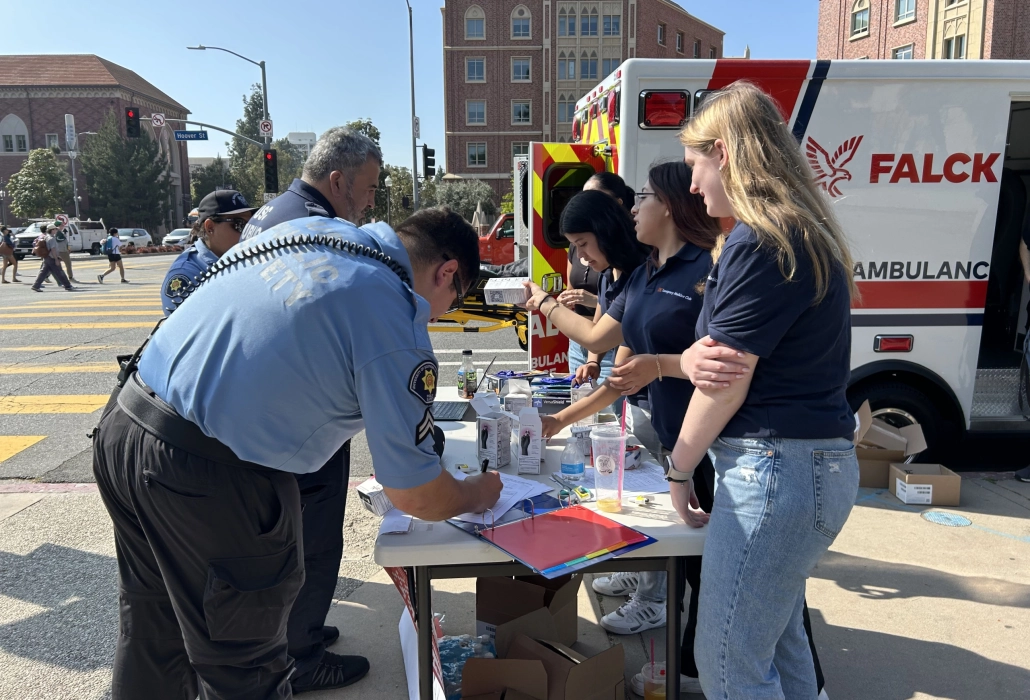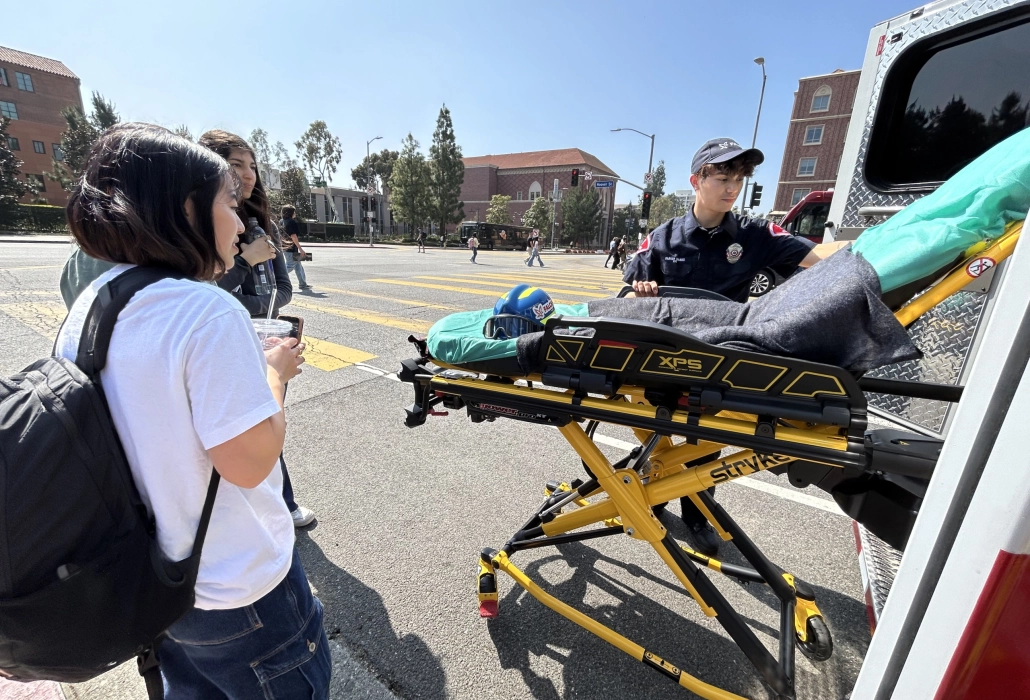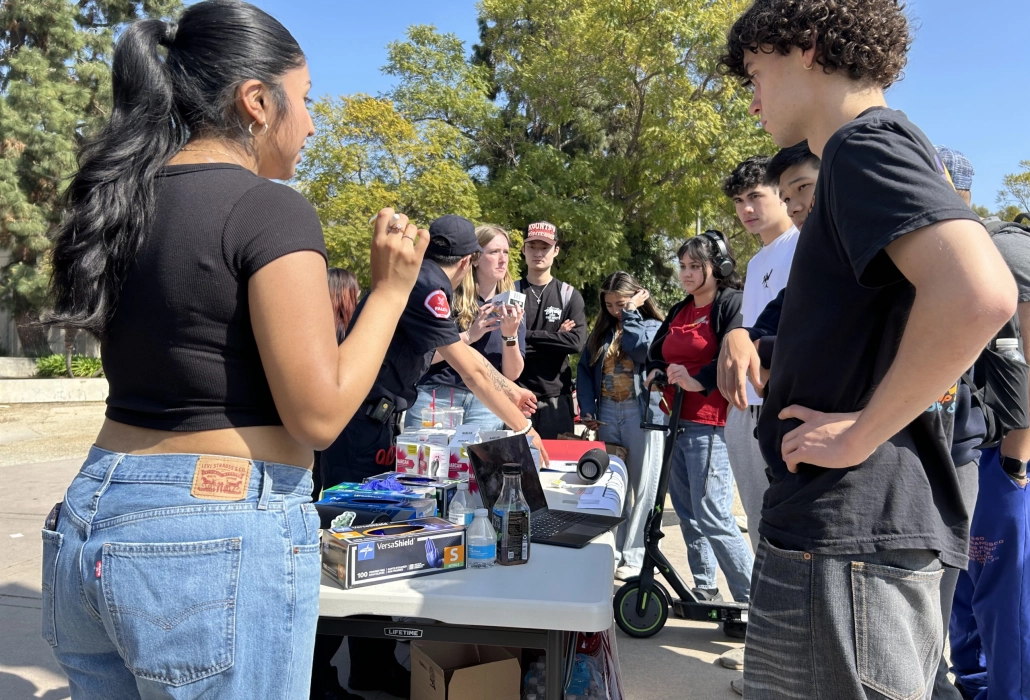New emergency medicine club promotes health, safety knowledge
Club members handed out $7,000 worth of Narcan after training passersby.
Club members handed out $7,000 worth of Narcan after training passersby.





Students, community members and Department of Public Safety officers all huddled around a white table at the Jefferson and Hoover intersection Wednesday with a large sign that hung from a table that read, “FREE NARCAN.” Sprawled across the table were new and half-opened Narcan kits, and it was where the Narcan training was held.
Inside an ambulance nearby stood Luke Sparks, a sophomore majoring in health promotion and disease prevention studies. He showed participants around the space and pointed out important medical equipment such as petroleum gauze for gunshot wounds, a bag valve mask for cardiac arrests and the siren lights, which can be used for emergencies or for fun.
At one point, a brave volunteer agreed to participate in Sparks’ demonstration of how to place a neck brace on someone.
Meanwhile, at the table, students in identical dark blue T-shirts explained the telltale signs of an overdose, how to administer Narcan and why it’s important to have it on hand. After they finished their presentation, participants lined up to get a certificate, fentanyl-resistant gloves and, as promised, a box of Narcan.
Sophia Dettweiler, the club’s treasurer and a sophomore majoring in health promotion and disease prevention studies as well as neuroscience, said that the certificate isn’t anything official, but the club does want to keep track of who has completed their training. Across the nation, overdose deaths continue to rise.
The Centers for Disease Control and Prevention classifies opioid overdoses as an “epidemic” and states more than 1 million people have died since 1999 from a drug overdose — with 75% of all drug overdose deaths involving an opioid. This class of drugs is used to prevent pain and includes prescription opioids, fentanyl and heroin.
Narcan is a life-saving drug used to stop opioid overdoses. Administering naloxone — the specific chemical in Narcan that reduces the effects of opioids — through either the nasal spray or in liquid form can prevent death caused by overdosing.
“We have been telling students all day that [an overdose] can truly happen to anyone,” Dettweiler said. “You might be taking something else that you don’t realize is cut with fentanyl … You might be walking down the street on your way back from class and see a stranger on the street, there’s going to be an overdose, and you could save their life. You never know.”
After four hours, The Emergency Medicine Club of USC gave out over 120 boxes of Narcan — worth over $7,000.
“[I] definitely feel more knowledgeable about [administering Narcan] and more comfortable to actually use it on someone,” said Enton Cheng, a graduate student studying finance.
The cost of Narcan is a “barrier to access,” said Hallie Yong, a senior majoring in global health. A box with one dose sells for around $50.
Lisette Perales, a junior majoring in psychology, was unaware she could obtain Narcan for free at Engemann Student Health Center. The guarantee of free Narcan is what brought her to the booth.
“I’ve been really getting used to the party scene,” Perales said. “I haven’t seen people use opioids, but I know it’s a big problem out here, and if someone needs the help, I want to be there to help.”
The EM Club of USC is seeking recognition as a student organization, though USC has had an ongoing pause on new applications since January. Dettweiler said they will apply again as soon as the application reopens next fall.
Sparks — the organization’s director and founder — wears many hats outside of the club. On top of being a full-time pre-med student at USC, he is an EMT-911 at Falck Ambulance, and he’s a clinical instructor at the UCLA Department of Emergency Medicine where he teaches lifesaving skills.
Part of the reason Sparks became an Emergency Medical Technician was because he said he wanted to learn what to do in a medical emergency after a few close calls with friends and family members. While on the job, he’s seen patients die due to opioid overdoses and said USC students need to do their best to care for the South Central community.
“I think it’s critical for everyone, not only pre-medical students, to get emergency medical training, whether it be CPR training or stop the bleed training,” Sparks said. “These are critical life-saving medical skills that everyone should know. I feel like they should be taught at a younger age.”
We are the only independent newspaper here at USC, run at every level by students. That means we aren’t tied down by any other interests but those of readers like you: the students, faculty, staff and South Central residents that together make up the USC community.
Independence is a double-edged sword: We have a unique lens into the University’s actions and policies, and can hold powerful figures accountable when others cannot. But that also means our budget is severely limited. We’re already spread thin as we compensate the writers, photographers, artists, designers and editors whose incredible work you see in our daily paper; as we work to revamp and expand our digital presence, we now have additional staff making podcasts, videos, webpages, our first ever magazine and social media content, who are at risk of being unable to receive the support they deserve.
We are therefore indebted to readers like you, who, by supporting us, help keep our paper daily (we are the only remaining college paper on the West Coast that prints every single weekday), independent, free and widely accessible.
Please consider supporting us. Even $1 goes a long way in supporting our work; if you are able, you can also support us with monthly, or even annual, donations. Thank you.
This site uses cookies. By continuing to browse the site, you are agreeing to our use of cookies.
Accept settingsDo Not AcceptWe may request cookies to be set on your device. We use cookies to let us know when you visit our websites, how you interact with us, to enrich your user experience, and to customize your relationship with our website.
Click on the different category headings to find out more. You can also change some of your preferences. Note that blocking some types of cookies may impact your experience on our websites and the services we are able to offer.
These cookies are strictly necessary to provide you with services available through our website and to use some of its features.
Because these cookies are strictly necessary to deliver the website, refusing them will have impact how our site functions. You always can block or delete cookies by changing your browser settings and force blocking all cookies on this website. But this will always prompt you to accept/refuse cookies when revisiting our site.
We fully respect if you want to refuse cookies but to avoid asking you again and again kindly allow us to store a cookie for that. You are free to opt out any time or opt in for other cookies to get a better experience. If you refuse cookies we will remove all set cookies in our domain.
We provide you with a list of stored cookies on your computer in our domain so you can check what we stored. Due to security reasons we are not able to show or modify cookies from other domains. You can check these in your browser security settings.
These cookies collect information that is used either in aggregate form to help us understand how our website is being used or how effective our marketing campaigns are, or to help us customize our website and application for you in order to enhance your experience.
If you do not want that we track your visit to our site you can disable tracking in your browser here:
We also use different external services like Google Webfonts, Google Maps, and external Video providers. Since these providers may collect personal data like your IP address we allow you to block them here. Please be aware that this might heavily reduce the functionality and appearance of our site. Changes will take effect once you reload the page.
Google Webfont Settings:
Google Map Settings:
Google reCaptcha Settings:
Vimeo and Youtube video embeds:
The following cookies are also needed - You can choose if you want to allow them:
